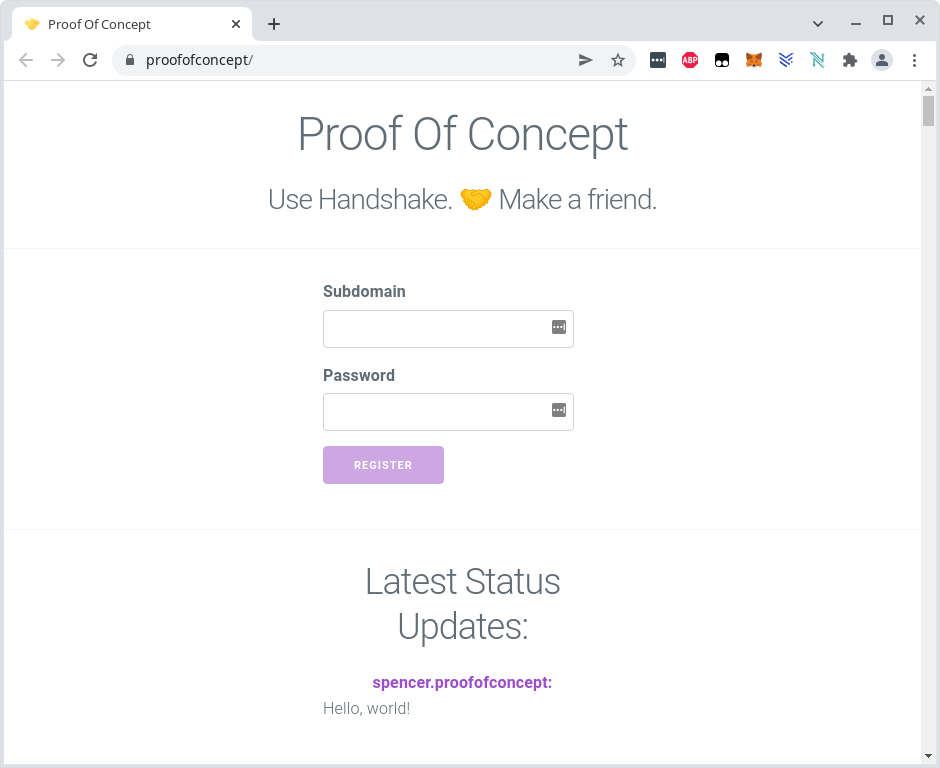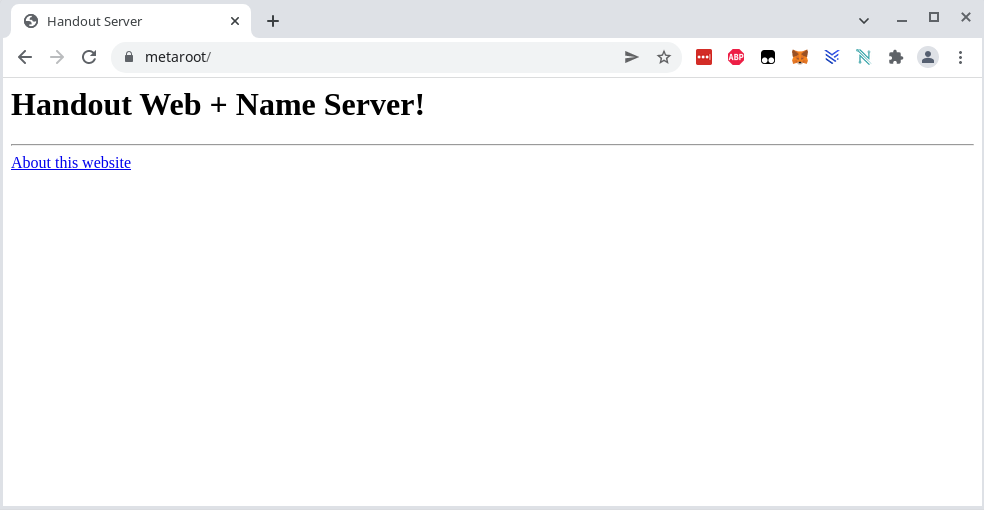We are using the HSD full node and the letsdane program to resolve TLDs from the Handshake blockchain.
The following was tested with the latest stable version of NodeJS. node --version showed v16.13.2.
Build and run HSD as described in the README page of the project:
git clone https://github.com/handshake-org/hsd.git
cd hsd
npm install --production
./bin/hsd --rs-host 0.0.0.0 --rs-port 5350
This needs a few hours until the blockchain is fully synched, and it needs about 14 GB in the ~/.hsd directory. See https://blockexplorer.com for the current latest block. It is done when you see the block in the debug output:
[debug] (wallet) Adding block: 102948.
If there are build problems, probably some libraries are missing. You need to install NodeJS and a few other libraries. For example on a Debian system I had to install this:
sudo apt-get install npm libunbound-dev libcap2-bin
npm install -g node-gyp
Build it as explained in the README page of the project:
git clone https://github.com/buffrr/letsdane
cd letsdane/cmd/letsdane/
go build -tags unbound
If there are build problems, there might be some packages missing, for example:
sudo apt-get install libunbound-dev
And it needs Go, see https://go.dev/doc/install how to install it.
After building, you need to export a certificate for your browser:
./letsdane -o myca.crt
Then you need to import the certificate in your browser. See for example here how to add it to Chrome.
Letsdane implements a proxy server for the name resolution and SSL wrapping. It uses the HSD recursive nameserver to resolv names. Start it like this:
./letsdane -r 127.0.0.1:5350 -skip-dnssec -skip-icann
Then you need to setup the proxy in the operating system. For example in Debian Linux open the proxy settings and configure it like this:
After changing the proxy settings, restart your browser, and you will be able to resolv handshake domains. Example with SSL encryption and just the TLD: https://proofofconcept
Another example of a forum with a subdomain and no SSL: http://handshake.mercenary
To run your own Handshake network, we are using a local regtest network of Handshake (currently there is no running global testnet). We also need to install our own nameserver.
Change to the hsd directory, then start the test.sh script in this directory, but with the leading ., to define all variables in the current shell:
cd hsd
. ../handshake-test/test.sh
Output should be like this:
hsd: no process found
starting server
receive address: rs1qesjl778cv5g0fn5gpahaw4cxz22e7wz7jp9lt4
mining coins
name: metaroot
blocks until auction starts: 6
blocks until auction reveal: 4
blocks until auction close: 9
After this, the hsd full node program is running the regtest network, with the root nameserver at port 25349, and the recursive server at port 25350.
The repository https://github.com/pinheadmz/handout has anything you need to create the DNS records for the DNSSEC nameserver, and it provides a DNSSEC aware nameserver and a secure webserver. Open a new terminal, clone the project and checkout the proofofconcept branch, and install it:
git clone -b proofofconcept https://github.com/pinheadmz/handout
cd handout
npm i
You can create the certificates and DNSSEC records for the TLD metaroot like this:
node scripts/hnssec-gen.js metaroot 127.0.0.1
The output should looks like this (the digest can vary) :
Generating SSL key and self-signed certificate...
Generating DNSSEC keys...
Writing new conf/handout.conf...
DS record for root zone:
metaroot. 172800 IN DS 19927 8 2 7F80DE0EDEBC345F27B3FE9E16EA2FD2B50F5E6353DF9C82A3EF7E65 E660BF57 ; alg = RSASHA256 ; hash = SHA256
GLUE4 record, Bob format:
ns.metaroot. 127.0.0.1
DS record, Bob format:
19927 8 2 7f80de0edebc345f27b3fe9e16ea2fd2b50f5e6353df9c82a3ef7e65e660bf57
All records, hsw-rpc sendupdate format:
{"records":[{"type":"GLUE4","ns":"ns.metaroot.","address":"127.0.0.1"},{"type":"DS","keyTag":19927,"algorithm":8,"digestType":2,"digest":"7f80de0edebc345f27b3fe9e16ea2fd2b50f5e6353df9c82a3ef7e65e660bf57"}]}
In the HSD terminal, you can now set the DNSSEC record. This stores the digest to validate the record in the regtest blockchain:
hsw-rpc sendupdate "$name" '{"records":[{"type":"GLUE4","ns":"ns.metaroot.","address":"127.0.0.1"},{"type":"DS","keyTag":19927,"algorithm":8,"digestType":2,"digest":"7f80de0edebc345f27b3fe9e16ea2fd2b50f5e6353df9c82a3ef7e65e660bf57"}]}'
mine 10
The mine 10 command mines 10 blocks, which is required to make the new record active.
Verify that the record was set:
hsd-rpc getnameresource "$name"
Output:
{
"records": [
{
"type": "GLUE4",
"ns": "ns.metaroot.",
"address": "127.0.0.1"
},
{
"type": "DS",
"keyTag": 11326,
"algorithm": 8,
"digestType": 2,
"digest": "8b167d1e80c9ec5af014150906ce13fef41e33ce030794a886781de749ba37ab"
}
]
}
Now start the nameserver and webserver in the handout terminal. Since this nameserver is bind to port 53, first you need to allow node programs to open ports below 1024 like this:
sudo setcap cap_net_bind_service=ep `which node`
Now you can start it:
node lib/handout.js
Output:
[debug] (webserver) Webserver opened at host 127.0.0.1
[debug] (authns) Authoritative Nameserver opened for domain metaroot.
You can query the root nameserver of the handout script like this:
dig @127.0.0.1 metaroot +dnssec
Output:
; <<>> DiG 9.11.5-P4-5.1+deb10u6-Debian <<>> @127.0.0.1 metaroot +dnssec
; (1 server found)
;; global options: +cmd
;; Got answer:
;; ->>HEADER<<- opcode: QUERY, status: NOERROR, id: 14846
;; flags: qr aa rd; QUERY: 1, ANSWER: 2, AUTHORITY: 0, ADDITIONAL: 1
;; WARNING: recursion requested but not available
;; OPT PSEUDOSECTION:
; EDNS: version: 0, flags: do; udp: 4096
;; QUESTION SECTION:
;metaroot. IN A
;; ANSWER SECTION:
metaroot. 21600 IN A 127.0.0.1
metaroot. 172800 IN RRSIG A 8 1 21600 20230124034412 20220123034412 53535 metaroot. dnah5tahMvwomU1Ig4DqdiJo/Sopk4N0X/IVmpASBf/RdfxtUQ85W7pG V1c2+V33v4lf1rOmYbP6dXqCGLZKXQ+jdR/wUIsshP0W0EX2o5y+RUrF Lsw43XQYAB1guWmSFf7M5g8nYf3xBoXlGsEOOJ5r0IS2Zr8cpTo48RD4 KcuMvd4MvL9f6/SC/LqIX0+uVsiXPAO0CuwFvfXX/mtn65OQ+GJrJFNy e8unX532HaRqeqlNBhOX0SAmKwhcC0KhVKpMWlCwZFBRB5VdvKD57o7L 73XbXomcYSn1+6T74iPudUIVnhePfvl/V9EEnR02qRdb9/ESrnfOLZck 9vdo5Q==
;; Query time: 0 msec
;; SERVER: 127.0.0.1#53(127.0.0.1)
;; WHEN: Mon Jan 24 05:03:59 CET 2022
;; MSG SIZE rcvd: 341
The integrated recursive nameserver of the HSD full node can be queried like this, and it uses the handout root nameserver:
dig @127.0.0.1 -p 25350 "$name" +dnssec
Output:
; <<>> DiG 9.11.5-P4-5.1+deb10u6-Debian <<>> @127.0.0.1 -p 25350 metaroot +dnssec
; (1 server found)
;; global options: +cmd
;; Got answer:
;; ->>HEADER<<- opcode: QUERY, status: NOERROR, id: 46865
;; flags: qr rd ra ad; QUERY: 1, ANSWER: 2, AUTHORITY: 0, ADDITIONAL: 2
;; OPT PSEUDOSECTION:
; EDNS: version: 0, flags: do; udp: 4096
; COOKIE: 24303290fd6e251e (echoed)
;; QUESTION SECTION:
;metaroot. IN A
;; ANSWER SECTION:
metaroot. 20358 IN A 127.0.0.1
metaroot. 85158 IN RRSIG A 8 1 21600 20230124034412 20220123034412 53535 metaroot. dnah5tahMvwomU1Ig4DqdiJo/Sopk4N0X/IVmpASBf/RdfxtUQ85W7pG V1c2+V33v4lf1rOmYbP6dXqCGLZKXQ+jdR/wUIsshP0W0EX2o5y+RUrF Lsw43XQYAB1guWmSFf7M5g8nYf3xBoXlGsEOOJ5r0IS2Zr8cpTo48RD4 KcuMvd4MvL9f6/SC/LqIX0+uVsiXPAO0CuwFvfXX/mtn65OQ+GJrJFNy e8unX532HaRqeqlNBhOX0SAmKwhcC0KhVKpMWlCwZFBRB5VdvKD57o7L 73XbXomcYSn1+6T74iPudUIVnhePfvl/V9EEnR02qRdb9/ESrnfOLZck 9vdo5Q==
;; SIG0 PSEUDOSECTION:
. 0 ANY SIG 0 253 0 0 20220124100505 20220123220505 64595 . NSDF0WIJytT6NxBJT5rcg5UAY1beyh+TBCv/Z3DUKw4H5bomJkb+OXHz A1Xt5ce/ZBxG7xGmh+2/ICgX3xhSWA==
;; Query time: 3 msec
;; SERVER: 127.0.0.1#25350(127.0.0.1)
;; WHEN: Mon Jan 24 05:05:05 CET 2022
;; MSG SIZE rcvd: 447
Finally restart letsdane with the new recursive nameserver:
./letsdane -r 127.0.0.1:25350 -skip-dnssec -skip-icann
Now you can open https://metaroot and it should look like this:



